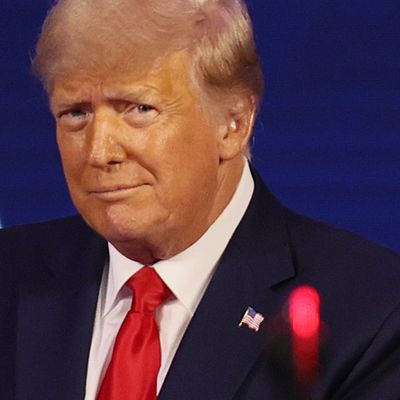
Donald Trump may be a man with a very limited set of talents, but he has learned to apply those talents to masterful effect. His talent is to employ shameless lies to create an image of himself in the media, and then use that media to bilk people.
Typically, a grifter runs up against the limits of public knowledge: Once he is exposed, it becomes progressively more difficult to find new marks. But here is where Trump’s particular genius exceeds all who came before him, and allowed him to operate his scam on a world-historical scale. Trump has always attracted so much media that any particular exposé of his crooked deeds is overwhelmed by the cacophony.
Shane Goldmacher reports at the New York Times that Trump’s campaign bilked donors out of tens of millions of dollars. The scam was not complicated. When people gave them money online, the donations came with pre-checked boxes authorizing the campaign to take donations every single week. They needed to uncheck the box to stop the automatic transfer.
At first the auto-checked box simply said, “Make this a recurring monthly donation.” Then it added, “Make this a recurring weekly donation until 11/3,” with a second box below it, with even more text, authorizing an additional one-time $100 donation on September 29.
Ultimately, the messages included two text-heavy boxes, filled with boldfaced, all-caps slogans, with a much less conspicuous line at the bottom informing whoever had made it through this mini op-ed that they were authorizing the campaign to drain their bank account. These images comes from the Times story:
Goldmacher found victims who faced serious financial hardship as a result of this scam. Even some professional political operatives sometimes failed to recognize the inconspicuous little box.
The story cannot tabulate how much the campaign raised from unwitting victims. Many of them simply paid without realizing it. The only measure of the size of the grift comes via people who recognized their bank accounts were losing funds every week and demanded a refund. There were a lot of them: The Trump campaign refunded $121 million, or $101 million more than the Biden campaign did.
Trump has been operating like this all along. His business hires contractors and then — by the hundreds — pays them half the promised fee, or nothing at all, knowing it can just find new contractors to unwittingly work for the famous Donald Trump. He bilks his fans into buying expensive vitamin scams, or investing in a casino that he loots, or signing up for expensive courses where the instructors take the students for all they’re worth.
Trump’s political career was — or, more pessimistically, is — an extension of his grifting career. He recognized conservative media as the perfect vehicle to identify a new and vast collection of marks. He ran as a populist and used the trust his voters placed in him to govern as a plutocrat. All the promises of restoring the factories that disappeared in the 1980s simply gave way to another tax cut for the rich.
It is a testament to Trump’s grifting genius that his victims continue to venerate him. Goldmacher’s story contains this utterly perfect sentence, describing one of the victims who was tricked into giving the campaign more than ten times what he intended to donate: “Like multiple other donors interviewed, though, he held Mr. Trump himself blameless, telling the Times, ‘I’m 100 percent loyal to Donald Trump.’”
Almost every confidence artist has had to flee from his victims after they realized the trick. Trump may be the greatest con man in history. His victims still adore him.
Update, April 5: Trump has written a response to the Times report:
He does not challenge any of the factual claims in the story. Most of the response is devoted to recycling his false claims that he actually won the 2020 election. What small bits of Trump’s response are even related to the topic of his campaign fraud are more inculpatory than exculpatory.
Trump claims “many people were so enthusiastic that they gave over and over, and in certain cases where they gave too much, we would promptly refund their contributions.” Of course, if his fans wanted to give “over and over,” the campaign wouldn’t have needed to automatically enroll them in a weekly donation scheme and bury the opt-out box beneath an ever-lengthening sequence of text.
His next line insists that “the overall dispute rate was less than 1% of donations.” Of course, that is the point: People only disputed the charges if they noticed them. The scheme was designed to skim money out of their bank accounts without them noticing.































